VisionX 420D Review: ASRock's mini-PC Lineup Continues to Impress
by Ganesh T S on September 1, 2014 9:00 AM ESTPerformance Metrics - II
In this section, we mainly look at benchmark modes in programs used on a day-to-day basis, i.e, application performance and not synthetic workloads.
x264 Benchmark
First off, we have some video encoding benchmarks courtesy of x264 HD Benchmark v5.0.
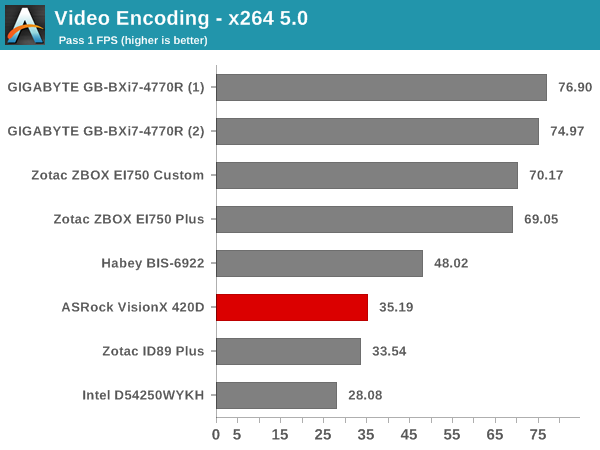
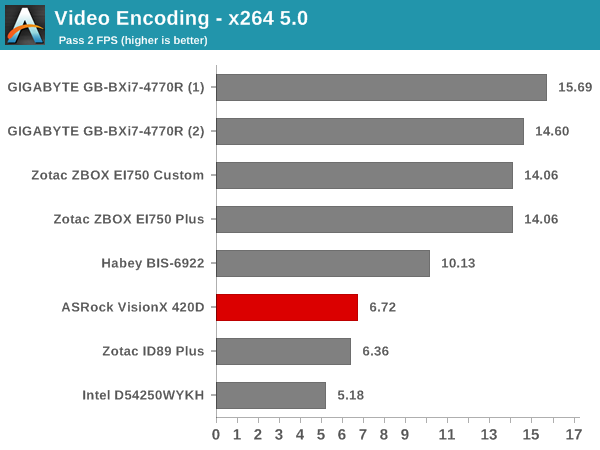
7-Zip
7-Zip is a very effective and efficient compression program, often beating out OpenCL accelerated commercial programs in benchmarks even while using just the CPU power. 7-Zip has a benchmarking program that provides tons of details regarding the underlying CPU's efficiency. In this subsection, we are interested in the compression and decompression MIPS ratings when utilizing all the available threads.
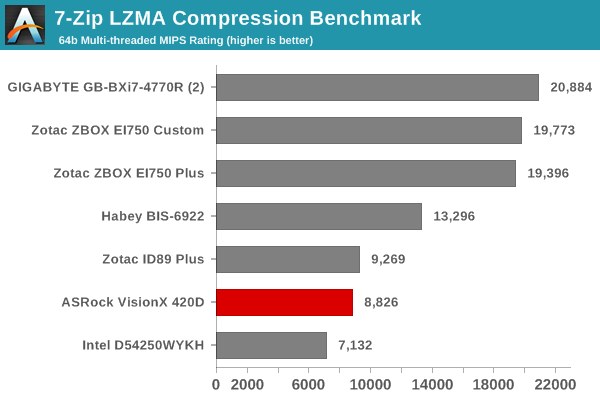

TrueCrypt
As businesses (and even home consumers) become more security conscious, the importance of encryption can't be overstated. CPUs supporting the AES-NI instruction for accelerating the encryption and decryption processes have, till now, been the higher end SKUs. However, with Bay Trail, even the lowly Atom series has gained support for AES-NI. The Core i5-4200M in the VisionX 420D does support AES-NI. TrueCrypt, a popular open-source disk encryption program can take advantage of the AES-NI capabilities. The TrueCrypt internal benchmark provides some interesting cryptography-related numbers to ponder. In the graph below, we can get an idea of how fast a TrueCrypt volume would behave in the VisionX 420D and how it would compare with other select PCs. This is a purely CPU feature / clock speed based test.
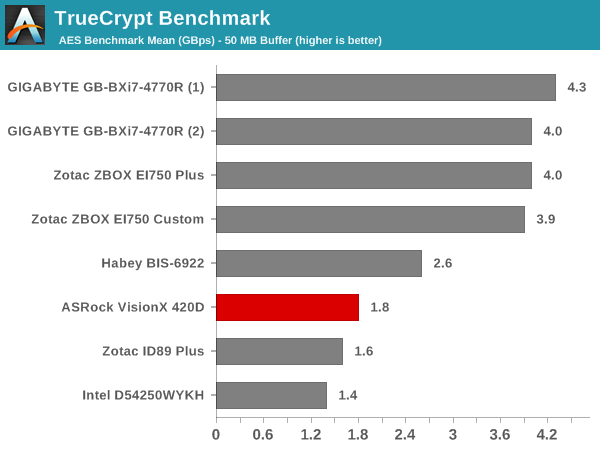
Agisoft Photoscan
Agisoft PhotoScan is a commercial program that converts 2D images into 3D point maps, meshes and textures. The program designers sent us a command line version in order to evaluate the efficiency of various systems that go under our review scanner. The command line version has two benchmark modes, one using the CPU and the other using both the CPU and GPU (via OpenCL). The benchmark takes around 50 photographs and does four stages of computation:
- Stage 1: Align Photographs
- Stage 2: Build Point Cloud (capable of OpenCL acceleration)
- Stage 3: Build Mesh
- Stage 4: Build Textures
We record the time taken for each stage. Since various elements of the software are single threaded, others multithreaded, and some use GPUs, it is interesting to record the effects of CPU generations, speeds, number of cores, DRAM parameters and the GPU using this software.
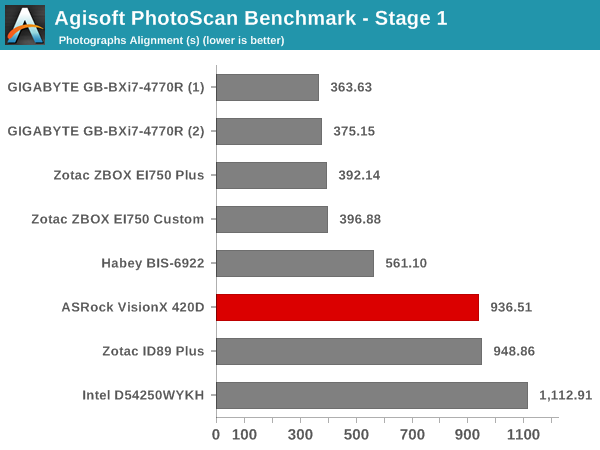
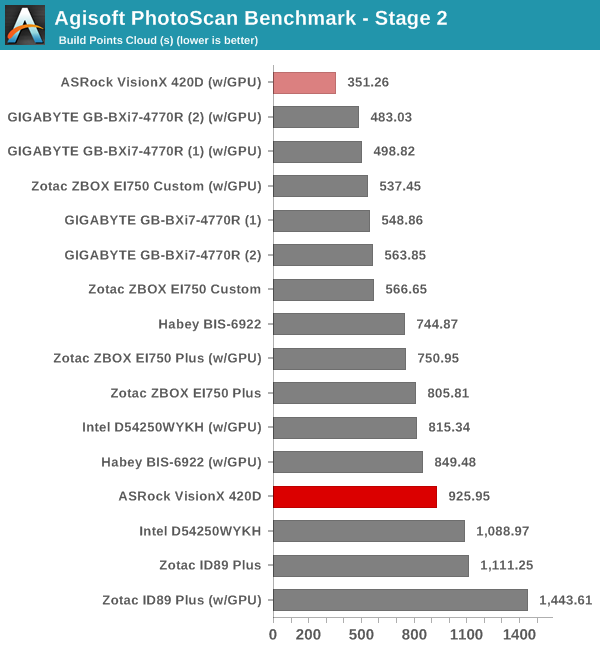
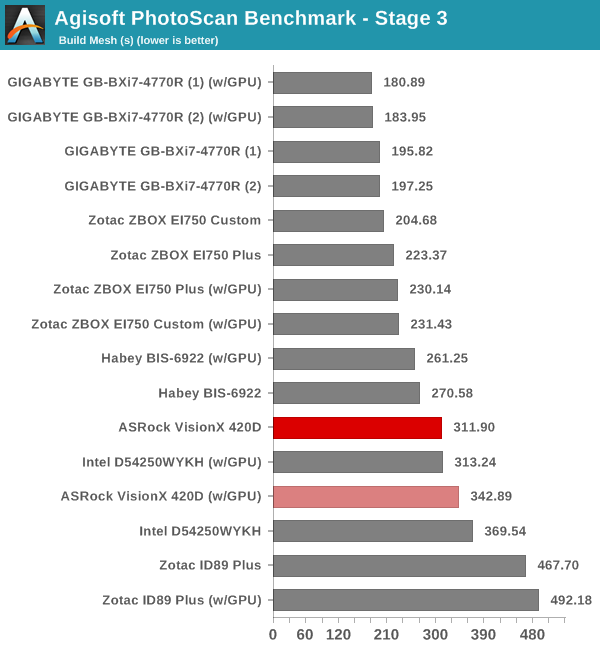
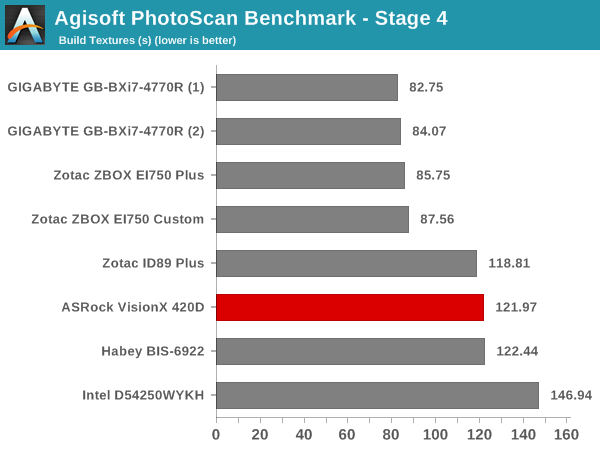
Dolphin Emulator
Wrapping up our application benchmark numbers is the Dolphin Emulator benchmark mode results.
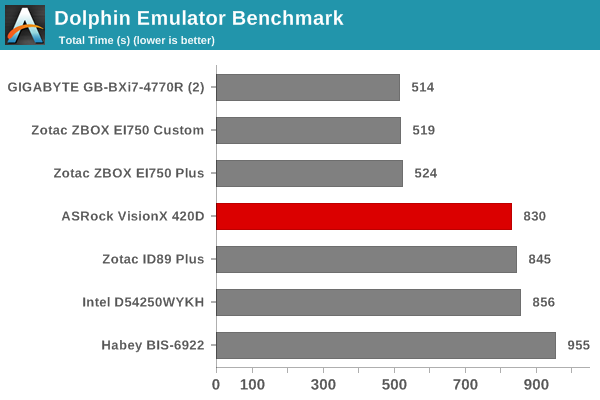










30 Comments
View All Comments
mschira - Monday, September 1, 2014 - link
Nice article, and interesting machine. I think the hardware documentation and pictures could be a bit better (disassembly), but otherwise a decent work.The lack of blue ray and 4K decoding are the obvious shortcomings, though mostly when one has a 4K TV - which I guess not many do.
boxof - Monday, September 1, 2014 - link
Any chance we can start getting sound recordings as part of SFF reviews? It'd be useful to get a sense of the nature of the sound (e.g. whiny) under load. Perhaps post some audio up to soundcloud or youtube if bandwidth is a concern.albiglan - Monday, September 1, 2014 - link
I'm also surprised by the lack of Blu-Ray option, but am noticing this more and more on laptops as well (no ODD, but if there is, it seems DVD only). I'm wondering if it is just a cost thing or if the format is on the decline?ET - Tuesday, September 2, 2014 - link
Yes, my problem with this too. Looks like a great little gaming HTPC but I'd love a blu-ray and a 2TB HD option (I'll add an mSATA SSD myself). Really, my current HTPC is a little long in the tooth, but has the benefit of 3.5" HD and standard 5.25" Blu-Ray drive support.Gadgety - Tuesday, September 2, 2014 - link
"The VisionX 420D has a much better acoustic profile compared to the BRIX Pro and even the ZBOX EI750 (thanks to the larger chassis, which, in turn, allows for a better thermal solution). Subjectively speaking..."Nice article. There's detailed objective measurements for just about every metric conceivable.That said there's always room for improvement. I find acoustics and noise to be just about the only area left to subjective impressions. Why is that? For these small boxes cooling and noise is where it's at in terms of separating the winners from losers, and that area is left to subjective impressions. Please include measurements and graphs of acoustic noise levels and signatures.
dj_aris - Tuesday, September 2, 2014 - link
Systems of such footprint literally crave for Maxwell. Maxwell is out for like 7 months now, why isn't it alredy in the hands of OEMs? AW Alpha is great and all but it's not here yet. Even Gigabyte has a low profile 750Ti ready now, I bet Asrock could have managed to fit that easily inside and make a perfectly capable mid/high 1080p machine.milkod2001 - Tuesday, September 2, 2014 - link
I'm not sure if there's something to like about 420D except the size.Looking at specs(medium class mobile CPU & GPU) and price($860),420D is basically laptop with no keyboard and screen. When you add cost of HD screen and keyboard(min.$120) you could get laptop with i7 quad & Maxwell 880M or proper PC gaming machine.
420D is pretty much useless for gaming unless you are happy with 7-13fps on 1080p and overkill & overpriced as office PC/HTPC.
I'm very confused with reviewer quite positive conclusion. What I'm missing here?
ganeshts - Tuesday, September 2, 2014 - link
The market segments are different. $120 in savings is still $120 when the use-case involves a notebook being docked to a display almost all the time.On the other hand, there is a reason why SFF PCs are becoming more and more popular compared to full-blown PC gaming machines - people appreciate and are willing to pay the premium for it. If the BRIX Pro and ZBOX EI750 are good Steam machines, the 420D is definitely much better at that job.
TrackSmart - Wednesday, September 3, 2014 - link
I think the point the poster is making is that these are *laptop specs* in a small PC that is marketed to gamers -- which means pretty weak performance.Someone interested in gaming (the target audience) would be much better off getting a slightly larger chassis with a low-power desktop CPU and GPU. You'd still get a fairly small chassis and low power consumption, but with a HUGE boost in gaming performance. That makes a lot more sense to me, given the supposed target audience (gamers).
Shadowmaster625 - Thursday, September 4, 2014 - link
For $100 more you can get a Yoga Y50 with a maxwell based gtx 860m. I'm sure there are several notebooks with better specs that are cheaper. What is the purpose of this form factor given the price premium compared to both desktops AND notebooks????